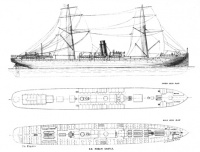
Among the main attractions were the impressive steam-powered ships exhibited by Messrs Barclay, Curle and Co. At the time, such vessels were one of the greatest examples of how far British engineering had come during the industry revolution.
In its 1888 report of the exhibition, The Engineer highlighted the Roslin Castle, built around five years earlier for Donald Curie and Co. It was a grand ship, 380ft in length and capable of achieving a speed of 14 ¾ knots. It was powered by compound direct-action surface-condensing engines having cylinders of 50 inches and 90 inches in diameter, and a 60-inch stroke.
“Its performance is creditable to its builders and itscommander”
It added of another ship in the exhibition, the County of Edinburgh: ’It is worthy of mention that, although of so large a size and propelled with so many sails, her late captain Mr Hood found her so easy to handle that he ventured upon the unique feat of setting sail upon her in the Penarth Dock and proceeded straight to sea without the aid of a tug or any other extraneous help, and when next heard had reached Bombay.
’Such a performance is creditable alike to the builders of the vessel and to the seamanship of her commander.’ Let us hope that this skill and ingenuity in design will be revived in the current generation of ship repairers. With the resurgence of the UK’s shipyards on the cards, these qualities are likely to be in demand.




Poll: Should the UK’s railways be renationalised?
The term innovation is bandied about in relation to rail almost as a mantra. Everything has to be innovative. There is precious little evidence of...